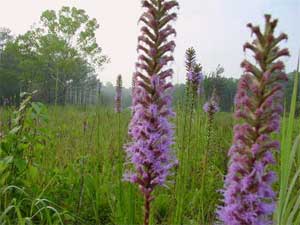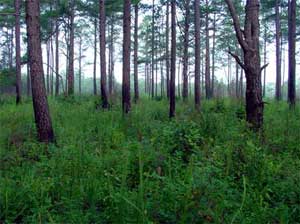



A previous graduate student, Doug Hohman, and I worked in a restored black prairie and an adjacent fire-maintained pine-oak savanna in Chickasaw County. Doug described the bird communities of these rare and unique plant communities. Doug and I also described the plant community of the unusual pine-oak savanna that is adjacent to the prairie.
Doug found that the black prairie is an ecological treasure as it relates to grassland bird diversity. Bachman's Sparrow uses and apparently breeds at our site. An important characteristic of the prairie complex is that it is a mosaic of grasslands dominated by big bluestem, indiangrass, and various composites and woodland hollows dominated by cedar, ash, and persimmon. Many birds typically considered grassland species can be found in these hollows.
The prairie is also a refuge for plant species not commonly found in other communities in Mississippi associated with more acid soils. These species include big bluestem, compass plant, purple prairie clover, prairie phlox, prairie liatris, and Great Plains' ladies tresses.
In contrast to the prairie, the pine-oak savanna we studied contained mostly common edge species of birds. However, it contained a unique mixture of woody and herbaceous plants, including shortleaf pine, black oak, black jack oak, post oak, little bluestem, candyroot, foxglove, butterfly weed, liatris, and numerous asters, goldenrods, and sunflowers. It is one of the only woodland sites in northern Mississippi in which we see successful regeneration of black jack oak, black oak, and post oak. These tree species, along with shortleaf pine, dominated the upland landscape on acid, non-calcareous soils in presettlement times.